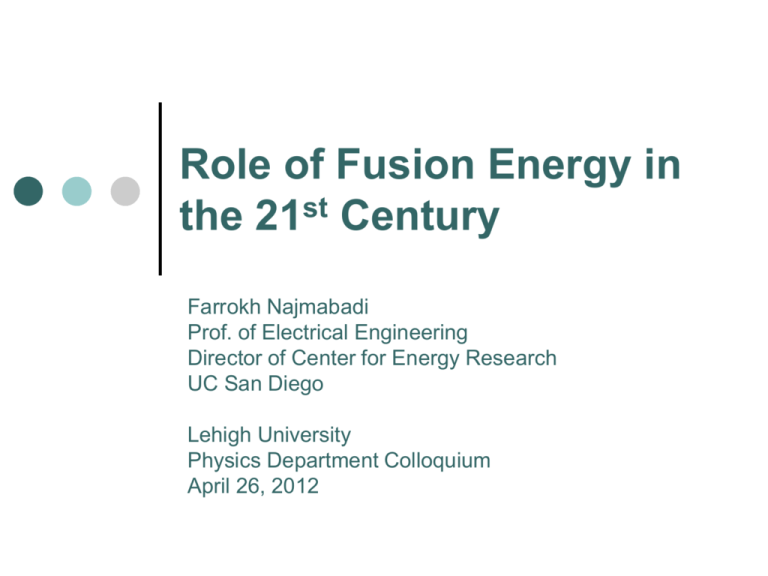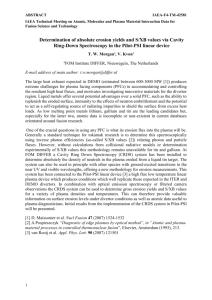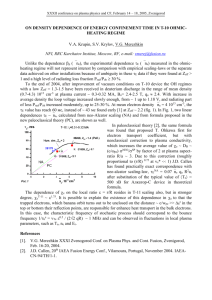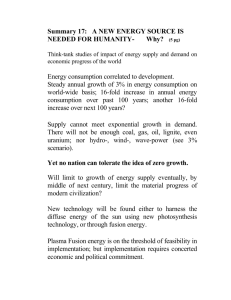PowerPoint - Fusion Energy Research Program
advertisement

Role of Fusion Energy in the 21st Century Farrokh Najmabadi Prof. of Electrical Engineering Director of Center for Energy Research UC San Diego Lehigh University Physics Department Colloquium April 26, 2012 UCSD Center for Energy Research Plasma Physics & Fusion Energy Solar Energy (renewable) forecasting & integration Fuel Cells Staff Graduate Students (PhD) Paid Student Researchers (non-Degree) Annual Research Funding (09-10) Number of Active Grants (09-10) Total Funding received (06-10) Number of Journal publications (06-10) Number of Conference papers (06-10) Professional Society Awards 90 25 15 $8.5M* 49 $40M 262 163 12 The Energy Challenge Scale: 1 EJ = 1018 J = 24 Mtoe 1TW = 31.5 EJ/year World energy use ~ 450 EJ/year ~ 14 TW Energy use increases with Economic Development 400 US Primary Energy per capita (GJ) 350 300 Australia 250 Russia 200 France Japan UK S. Korea 150 Ireland 100 Malaysia Mexico 50 China 0 0 India Greece Brazil 5,000 10,000 15,000 20,000 25,000 30,000 35,000 40,000 GDP per capita (PPP, $2000) With industrialization of emerging nations, energy use is expected to grow ~ 4 fold in this century (average 1.6% annual growth rate) Data from IEA World Energy Outlook 2006 Quality of Life is strongly correlated to energy use. HDI: (index reflecting life expectancy at birth + adult literacy & school enrolment + GNP (PPP) per capita) Typical goals: HDI of 0.9 at 3 toe per capita for developing countries. For all developing countries to reach this point, would need world energy use to double with today’s population, or increase 2.6 fold with the 8.1 billion expected in 2030. World Energy Demand (Mtoe) World Primary Energy Demand is expect to grow substantially Data from IAE World Energy Outlook 2006 Reference (Red) and Alternative (Blue) scenarios. World population is projected to grow from 6.4B (2004) to 8.1B (2030). Scenarios are very sensitive to assumption about China. Energy supply will be dominated by fossil fuels for the foreseeable future ’04 – ’30 Annual Growth Rate (%) M toe 18,000 16,000 14,000 12,000 10,000 Other Renew ables 6.5 Biomass & w aste 1.3 Hydro 2.0 Nuclear 0.7 Gas 2.0 Oil 1.3 Coal 1.8 8,000 6,000 4,000 2,000 0 1980 2004 2010 2015 Source: IEA World Energy Outlook 2006 (Reference Case), Business as Usual (BAU) case 2030 Total 1.6 Technologies to meet the energy challenge do not exist Improved efficiency and lower demand Huge scope but demand has always risen faster due to long turn-over time. Renewables Intermittency, cost, environmental impact. Carbon sequestration Requires handling large amounts of C (Emissions to 2050 =2000Gtonne CO2) Fission Fuel cycle and waste disposal Fusion Probably a large contributor in the 2nd half of the century Energy Challenge: A Summary Large increases in energy use is expected. IEA world Energy Outlook indicate that it will require increased use of fossil fuels Air pollution & Global Warming Will run out sooner or later Limiting CO2 to 550ppm by 2050 is an ambitious goal. USDOE: “The technology to generate this amount of emission-free power does not exist.” IEA report: “Achieving a truly sustainable energy system will call for radical breakthroughs that alter how we produce and use energy.” Public funding of energy research is down 50% since 1980 (in real term). World energy R&D expenditure is 0.25% of energy market of $4.5 trillion. Most of public energy expenditures is in the form of subsidies Energy Subsides (€28B) and R&D (€2B) in the EU Renewables 18% Fission 6% Coal 44.5% Fusion 1.5% Oil and gas 30% Slide from C. Llewellyn Smith, UKAEA Source : EEA, Energy subsidies in the European Union: A brief overview, 2004. Fusion and fission are displayed separately using the IEA governmentR&D data base and EURATOM 6th framework programme data Fission (seeking a significant fraction of World Energy Consumption of 14TW) Nuclear power is already a large contributor to world energy supply Nuclear power provide 8% of world total energy demand (20% of US electricity) Operating reactors in 31 countries 438 nuclear plants generating 353 GWe Half of reactors in US, Japan, and France 104 reactor is US, 69 in France US Nuclear Electricity (GWh) 30 New plants in 12 countries under construction 1000 No new plant in US for more 800 than two decades Increased production due to higher availability 600 400 30% of US electricity growth Equivalent to 25 1GW plants Extended license for many plants 200 0 1990 1994 2000 2001 2002 Evolution of Fission Reactors Challenges to Long-term viability of fission Economics: Reduced costs Reduced financial risk (especially licensing/construction time) Safety Protection from core damage (reduce likelihood) Eliminate offsite radioactive release potential Sustainability Efficient fuel utilization Waste minimization and management Non-proliferation Reprocessing and Transmutation Gen IV Reactors Fusion: Looking into the future ARIES-AT tokamak Power plant Brining a Star to Earth D + T 4He (3.5 MeV) + n (14 MeV) T n + 6Li 4He (2 MeV) + T (2.7 MeV) n D + 6Li 2 4He + 3.5 MeV (Plasma) + 17 MeV (Blanket) DT fusion has the largest cross section and lowest temperature (~100M oC). But, it is still a high-temperature plasma! Plasma should be surrounded by a Li-containing blanket to generate T. Or, DT fusion turns its waste (neutrons) into fuel! Through careful design, only a small fraction of neutrons are absorbed in structure and induce radioactivity. For liquid coolant/breeders (e.g., Li, LiPb), most of fusion energy is directly deposited in the coolant simplifying energy recovery Practically no resource limit (1011 TWy D; 104 (108) TWy 6Li) Fusion Energy Requirements: Confining the plasma so that alpha particles sustain fusion burn Lawson Criteria: ntE ~ 1021 s/m3 Heating the plasma for fusion reactions to occur to 100 Million oC (routinely done in present experiments) Optimizing plasma confinement device to minimize the cost Smaller devices Cheaper systems, e.g., lower-field magnets (MFE) or lowerpower lasers (IFE) Extracting the fusion power and breeding tritium Co-existence of a hot plasma with material interface Developing power extraction technology that can operate in fusion environment Two Approaches to Fusion Power – 1) Inertial Fusion Inertial Fusion Energy (IFE) Fast implosion of high-density DT capsules by laser or particle beams (~30 fold radial convergence, heating to fusion temperature). A DT burn front is generated, fusing ~1/3 of fuel (to be demonstrated in National Ignition Facility in Lawrence Livermore National Lab). Several ~300 MJ explosions per second with large gain (fusion power/input power). Two Approaches to Fusion Power – 2) Magnetic Fusion Magnetic Fusion Energy (MFE) Particles confined within a “toroidal magnetic bottle” for 10’s km and 100’s of collisions per fusion event. Strong magnetic pressure (100’s atm) to confine a low density but high pressure (10’s atm) plasma. At sufficient plasma pressure and “confinement time”, the 4He power deposited in the plasma sustains fusion condition. Rest of the Talk is focused on MFE Plasma behavior is dominated by “collective” effects Pressure balance (equilibrium) does not guaranty stability. Example: Interchange stability Fluid Interchange Instability Outside part of torus inside part of torus Impossible to design a “toroidal magnetic bottle” with good curvatures everywhere. Fortunately, because of high speed of particles, an “averaged” good curvature is sufficient. Tokamak is the most successful concept for plasma confinement DIII-D, General Atomics Largest US tokamak R=1.7 m Many other configurations possible depending on the value and profile of “q” and how it is generated (internally or externally) T3 Tokamak achieved the first high temperature (10 M oC) plasma 0.06 MA Plasma Current R=1 m JET is currently the largest tokamak in the world ITER Burning plasma experiment (under construction) R=3 m R=6 m Progress in plasma confinement has been impressive Fusion triple product n (1021 m-3) t(s) T(keV) ITER Burning plasma experiment 500 MW of fusion Power for 300s Construction has started in France Large amount of fusion power has also been produced ITER Burning plasma experiment DT Experiments DD Experiments Fusion Energy Requirements: Confining the plasma so that alpha particles sustain fusion burn Lawson Criteria: ntE ~ 1021 s/m3 Heating the plasma for fusion reactions to occur to 100 Million oC (routinely done in present experiments) Optimizing plasma confinement device to minimize the cost Smaller devices Cheaper systems, e.g., lower-field magnets (MFE) or lowerpower lasers (IFE) Extracting the fusion power and breeding tritium ITER and Satellite tokamaks (e.g., JT60-SU in Japan) Developing power extraction technology that can operate in fusion shouldenvironment demonstrate operation of a fusion plasma (and its support technologies) atwith thematerial power plant scale. Co-existence of a hot plasma interface ITER Device History 1988-1990 EU, Japan, USSR, and US conducted the Conceptual Design Activity 1992 Engineering Design Activity (EDA) Started 1998 Initial EDA ended. US urged rescoring to reduce cost 1998 US withdraws from ITER at Congressional Direction. EU, Japan, RF pursue a lower cost design 2001 EDA ends 2003 US, Korea, and China join ITER 2006 Agreement on ITER Site 2009 Construction of long-lead time components started 2017? First Plasma 2026? Full power DT experiments We have made tremendous progress in optimizing fusion plasmas Substantial improvement in plasma performance though optimization of plasma shape, profiles, and feedback. Achieving plasma stability at high plasma pressure. Achieving improved plasma confinement through suppression of plasma turbulence, the “transport barrier.” Progress toward steady-state operation through minimization of power needed to maintain plasma current through profile control. Controlling the boundary layer between plasma and vessel wall to avoid localized particle and heat loads. ITER and satellite tokamaks will provide the necessary data for a fusion power plant DIII-D Simultaneous Major toroidal radius (m) 1.7 Plasma Current (MA) 2.25 Magnetic field (T) 2 Electron temperature (keV) 7.5* Ion Temperature (keV) 18* Density (1020 m-3) 1.0* Confinement time (s) 0.4 Normalized confinement, H89 4.5 b (plasma/magnetic pressure) 6.7% Normalized b 3.9 Fusion Power (MW) Pulse length * Peak value, **Average Value DIII-D ITER Max Baseline 1.7 6.2 3.0 15 2 5.3 16* 8.9** 27* 8.1** 1.7* 1.0** 0.5 3.7 4.5 2 13% 2.5% 6.0 1.8 500 300 ARIES-AT 5.2 13 6.0 18** 18** 2.2** 1.7 2.7 9.2% 5.4 1,755 S.S. Fusion Energy Requirements: Confining the plasma so that alpha particles sustain fusion burn Lawson Criteria: ntE ~ 1021 s/m3 Heating the plasma for fusion reactions to occur to 100 Million oC (routinely done in present experiments) Optimizing plasma confinement device to minimize the cost Smaller devices Cheaper systems, e.g., lower-field magnets (MFE) or lower-power lasers (IFE) Extracting the fusion power and breeding tritium Developing power extraction technology that can operate in fusion environment Co-existence of a hot plasma with material interface First wall and blanket System is subject to a harsh environment Environment: Outboard blanket & first wall Surface heat flux (due to X-ray and ions) First wall erosion by ions. Radiation damage by neutrons (e.g. structural material) Volumetric heating by neutrons in the blanket. MHD effects Functions: Tritium breeding management Maximize power recovery and coolant outlet temperature for maximum thermal efficiency Constraints: Simple manufacturing technique Safety (low afterheat and activity) x ray Neutrons ions New structural material should be developed for fusion application Fe-9Cr steels: builds upon 9Cr-1Mo industrial experience and materials database (9-12 Cr ODS steels are a higher temperature future option) SiC/SiC: High risk, high performance option (early in its development path) W alloys: High performance option for PFCs (early in its development path) Irradiation leads to a operating temperature window for material Structural Material Operating Temperature Windows: 10-50 dpa Radiation embrittlement Carnot=1-Treject/Thigh Thermal creep Zinkle and Ghoniem, Fusion Engr. Des. 49-50 (2000) 709 Additional considerations such as He embrittlement and chemical compatibility may impose further restrictions on operating window Several blanket Concepts have been developed Dual coolant with a self-cooled PbLi zone, He-cooled RAFS structure and SiC insert Simple, low pressure design with SiC structure and LiPb coolant and breeder. Innovative design leads to high LiPb outlet temperature (~1,100oC) while keeping SiC structure temperature below 1,000oC leading to a high thermal efficiency of ~ 60%. Flow configuration allows for a coolant outlet temperature to be higher than maximum structure temperature Design leads to a LiPb Outlet Temperature of 1,100oC While Keeping SiC Temperature Below 1,000oC PbLi Inlet Temp. = 764 °C • Two-pass PbLi flow, first pass to cool SiCf/SiC box second pass to superheat PbLi Max. SiC/SiC Temp. = 996°C Max. SiC/PbLi Interf. Temp. = 994 °C First Wall Channel vback Bottom Pb-17Li q''plasma q''back Inner Channel Poloidal q'''LiPb Top Radial SiC/SiC First Wall PbLi Outlet Temp. = 1100 °C vFW Out SiC/SiC Inner Wall Managing the plasma material interface is challenging Alpha power and alpha ash has to eventually leave the plasma Confined plasma Flux surface Separatrix First Wall Particle and energy flux on the material surrounding the plasma Modern tokomaks use divertors: Closed flux surfaces containing hot core plasma Open flux surfaces containing cold plasma diverted away from the first wall. Particle flux on the first wall is reduced, heat flux on the first wall is mainly due to radiation (bremsstrahlung, synchrotron, etc.) Alpha ash is pumped out in the divertor region High heat and particle fluxes on the divertor plates. Edge Plasma Divertor plates Several Gad-cooled W divertor Concepts has been produced. Mass flow rate [g/s] EU finger: 2.6 cm diameter Impinging multi-jet cooling Allowable heat flux >10 MW/m2 ~535,000 units for a power plant Pp* / P * Nup / Nu Plate: 20 cm x 100 cm Impinging slot-jet cooling Allowable heat flux ~10 MW/m2 ~750 units for a power plant Nominal operating condition Re (/104) Thermal hydraulic experiments confirm very high heat transfer for slot jet cooling H > 50 kW/(m2K) is possible The ARIES-AT utilizes an efficient superconducting magnet design On-axis toroidal field: 6T Peak field at TF coil: 11.4 T TF Structure: Caps and straps support loads without inter-coil structure; Superconducting Material Either LTC superconductor (Nb3Sn and NbTi) or HTC Structural Plates with grooves for winding only the conductor. Radioactivity levels in fusion power plants are very low and decay rapidly after shutdown 1 10 SiC composites lead to a very low activation and afterheat. All components of ARIES-AT qualify for Class-C disposal under NRC and Fetter Limits. 90% of components qualify for Class-A waste. 0 10 Ferritic Steel -1 th Activity (Ci/W ) 10 Vanadium -2 10 -3 10 -4 10 ARIES-ST ARIES-RS -5 10 -6 10 1 mo 1d 100 y 1y -7 10 4 10 5 10 6 10 7 10 8 10 9 10 10 10 11 10 Time Following Shutdown (s) After 100 years, only 10,000 Curies of radioactivity remain in the 585 tonne ARIES-RS fusion core. Level in Coal Ash Waste volume is not large 1270 m3 of Waste is generated after 40 full-power year (FPY) of operation. Coolant is reused in other power plants 29 m3 every 4 years (component replacement), 993 m3 at end of service Equivalent to ~ 30 m3 of waste per FPY 400 90% of waste qualifies for 1400 Cumulative Compacted Waste Volume (m3) Cumulative Compacted Waste Volume (m3) Effective annual waste can be reduced by increasing plant service life. 350 300 250 200 150 100 50 Class A disposal 1200 1000 800 600 400 200 0 Blanket Shield Vacuum Vessel Magnets Structure Cryostat 0 Class A Class C Advances in fusion science & technology has dramatically improved our vision of fusion power plants Major radius (m) Estimated Cost of Electricity (c/kWh) 10 14 12 9 8 7 10 8 6 5 6 4 4 3 2 2 0 1 0 Mid 80's Pulsar Early 90's ARIES-I Late 90's ARIES-RS 2000 ARIES-AT Mid 80's Physics Early 90's Physics Late 90's Physics Advanced Technology In Summary, … In a CO2 constrained world uncertainty abounds No carbon-neutral commercial energy technology is available today. Carbon sequestration is the determining factor for fossil fuel electric generation. A large investment in energy R&D is needed. A shift to a hydrogen economy or carbon-neutral syn-fuels is also needed to allow continued use of liquid fuels for transportation. Problem cannot be solved by legislation or subsidy. We need technical solutions. Technical Communities should be involved or considerable public resources would be wasted The size of energy market ($1T annual sale, TW of power) is huge. Solutions should fit this size market 100 Nuclear plants = 20% of electricity production $50B annual R&D represents 5% of energy sale Status of fusion power Over 15 MW of fusion power is generated (JET, 1997) establishing “scientific feasibility” of fusion power Although fusion power < input power. ITER will demonstrate “technical feasibility” of fusion power by generating copious amount of fusion power (500MW for 300s) with fusion power > 10 input power. Tremendous progress in understanding plasmas has helped optimize plasma performance considerably. Vision of attractive fusion power plants exists. Transformation of fusion into a power plant requires considerable R&D in material and fusion nuclear technologies (largely ignored or under-funded to date). This step, however, can be done in parallel with ITER Large synergy between fusion nuclear technology R&D and Gen-IV. Thank You





